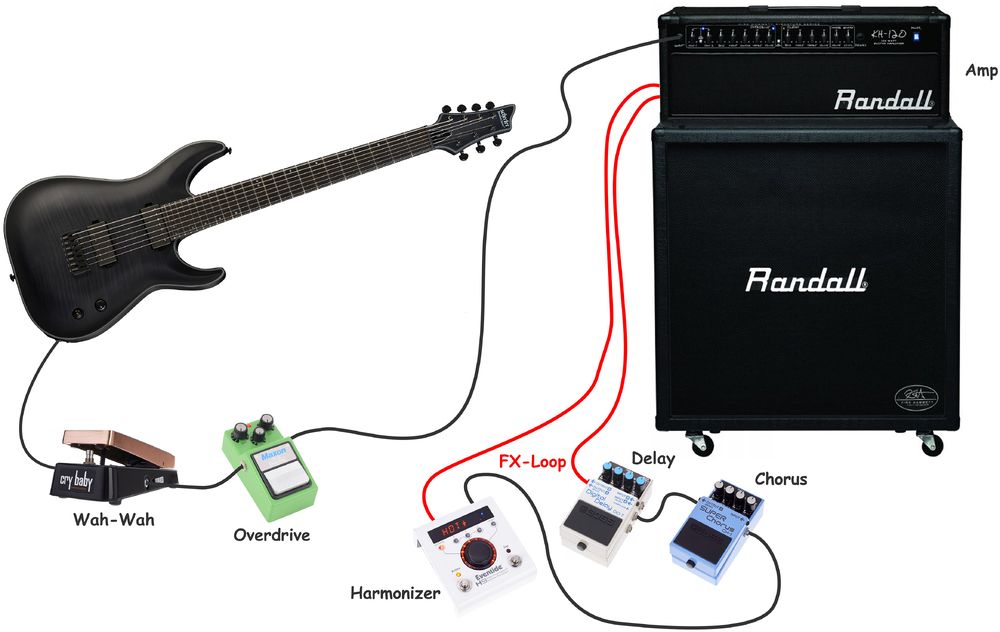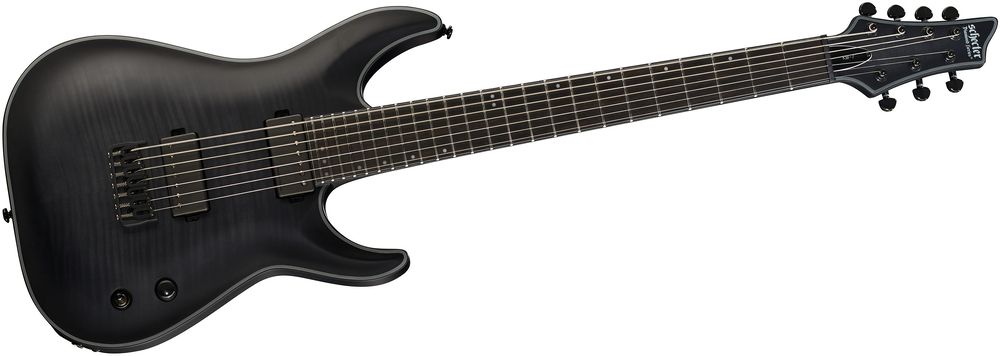4. Metal Setup
Here, we're generally talking about the harder edge. We've consciously skipped distinctions like hard, heavy, speed, or new metal because they all share one thing: they want it to pack a serious punch!
There isn't a single true metal sound, but we can sum up a few guidelines.
An essential element has always been and still is distortion. So, amps that can deliver this are in high demand. Unlike blues, where power amp distortion is primarily sought, here, it can be the much rougher preamp distortion.
The power amp shouldn't crumble too early because, given that drummers and bassists also go full throttle in this genre, volume is crucial. However, many guitarists (probably for the showy effect of a complete wall of amps) tend to overdo it.
Guitar:
As always, the rule here is: almost any guitar can play any style of music. However, there are trends:
As hard rock evolved from tough blues rock in the late 60s and early 70s (later terms like heavy rock and heavy metal just indicated it got even harder/more metallic), it was mainly humbucker-equipped guitars like Les Pauls and SGs that, paired with Marshall's towering black stacks, delivered the desired sound. Think Jimmy Page from Led Zeppelin, Toni Iommi from Black Sabbath, or Mick Box from Uriah Heep.
When single-coil guitars were used, treble boosters or distortions were usually applied to push amps that didn't yet have a master volume into overdrive. For instance, Ritchie Blackmore from Deep Purple ingeniously repurposed his tape echo unit to blast his 200-watt Marshalls through the roof. Guitarists back then were just more creative than today, where there's a store-bought solution for every little issue. Particularly favored by fans of harder genres is swapping pickups for higher output ones. You can learn more about this in our Pickup Online Guide.
The Strat + Tower or Les Paul + Tower combination remained the go-to throughout the 70s, but there were also other variants. Michael Schenker always played his Flying V, and brother Rudolf was never without that striking instrument that Gibson had totally flopped with in the late 50s.
Towards the late 70s, Eddie Van Halen revolutionized the guitar landscape. His Strat-style guitar with a humbucker at the bridge is still around today and, especially combined with neck and middle single coils, is remarkably versatile. For instance, the variation used by Steve Vai, with neck and bridge humbuckers and an additional single coil in the middle, brings a similar feel. Eddie Van Halen also popularized the Floyd Rose vibrato system (and all variations built under FR license). If someone is into intense whammy effects like dive-bombs, horse whinnies, or Harley revs, they're well-equipped with one of these (relatively) detuning-free vibratos.
However, Les Pauls also regained their ground (after almost fading away in the 80s), and even SGs (which in the 80s and 90s were exclusively Angus from AC/DC's choice) are quite common again. Yet, the prevailing guitar is likely the Superstrat, a guitar with a Strat-like body, a typically high-output humbucker at the bridge, and the previously mentioned variations for additional pickups.
There are suitable guitars from all manufacturers: apart from the already mentioned Fender and Gibson/Epiphone for more traditional shapes, there are Ibanez, ESP/LTD, Yamaha, Jackson/Charvel, and even the high-end PRS guitars, now frequently seen on heavy stages.
Amp:
Despite all competition, Marshall has managed to hold its place in the amplifier world over the years. Yet today, many companies build excellent amps for hard rock music. Mesa/Boogie, a company originally known for small, warm-sounding premium combos, has provided the official gear for the hardcore with their Rectifiers in recent years: even more distortion and a rather bass-heavy but mid-scarce frequency spectrum compared to more traditional rock music, particularly embraced by the younger representatives of the new metal genre.
However, companies like Peavey, Soldano, Hughes & Kettner, and Engl also craft outstanding amps. Every modeling amp has the suitable models for hard tones onboard. It's quite normal for these kinds of amps to offer 2 or more channels, providing options like clean, rhythm, and lead at the push of a button. Traditionally, for hard rock music, heads and 4x12 cabinets are used, and that hasn't really changed. Most cabinets from different manufacturers contain Celestion speakers. The company offers a wide range of speaker models, ensuring you'll find the right speaker for your sound.
Effects:
Effect-wise, anything goes: Rough distortions and the good old Wah-Wah pedal have always been popular. Yet, creating noise with a flanger can be beautiful, and a good digital delay often adds the crucial drama to a solo. If it's meant to sound truly evil, an octaver or pitch shifter is the right choice. And for those who want to pull off Vai-style harmonies, trying out an Intelligent Pitch Shifter is a must.
Technical note: As there's high distortion at play here, one must carefully consider the placement of effects. Flanger, chorus, or pitch shifter before the amp input produce noticeable noise due to preamp distortion, and a preceding delay squished by a distorted preamp usually sounds like garbage. So, the right place for these parts would be the effects loop. Wah, distortion, and octaver belong generally before the amp. Even a phaser usually sounds more musical in this setup.
Arrangement:
- Guitar
- Wah
- Distortion
- Octaver
- AMP Preamp
- FX send
- Flanger/Chorus
- Pitch Shifter
- Delay
- FX return - AMP Poweramp
- Cabinet
Many guitarists also use 19-inch rack effects: If it's a model with preamp, distortion, etc., it belongs before the amp (this applies to various modeling multis as well). However, one must handle the amplifier's built-in distortion cautiously. For other effects (modulation, delay, reverb), the effect loop is, of course, the right choice.
Sound:
Clean: Interestingly, in the heavy genre, they appreciate strong contrasts, and the clean sound should really remain undistorted if and when it's needed. Superstrat-equipped guitars are perfect for this. Clean channel on the amp, perhaps the neck-middle combination, and maybe a chorus or flanger.
Rhythm: This should get intense, and gain-wise, it usually leans towards the lead spectrum. Most typical amps cater to this preference, offering a gain-packed crunch or lead sound. Effects are possible but tend to wash out the sound during fast rhythm work.
Lead: Full throttle! Switch to the lead channel and, if desired, give it that extra edge with the distortion. Delay works well here, and the Wah-Wah pedal can add another dimension (Kirk Hammett from Metallica mostly uses his to "color" the sound of his solos, more as sound control than a Wah-Wah. Michael Schenker usually leaves it in a fixed position to boost a specific mid-frequency, that typical Schenker sound). With the pitch shifter, you can achieve interesting, even quirky intervals or even dual-voice passages, and an octaver just sounds pretty wicked.

Schematic layout of a metal setup (expandable based on taste)



